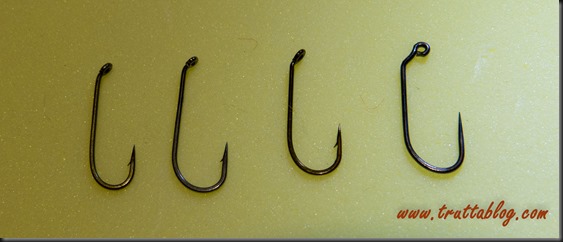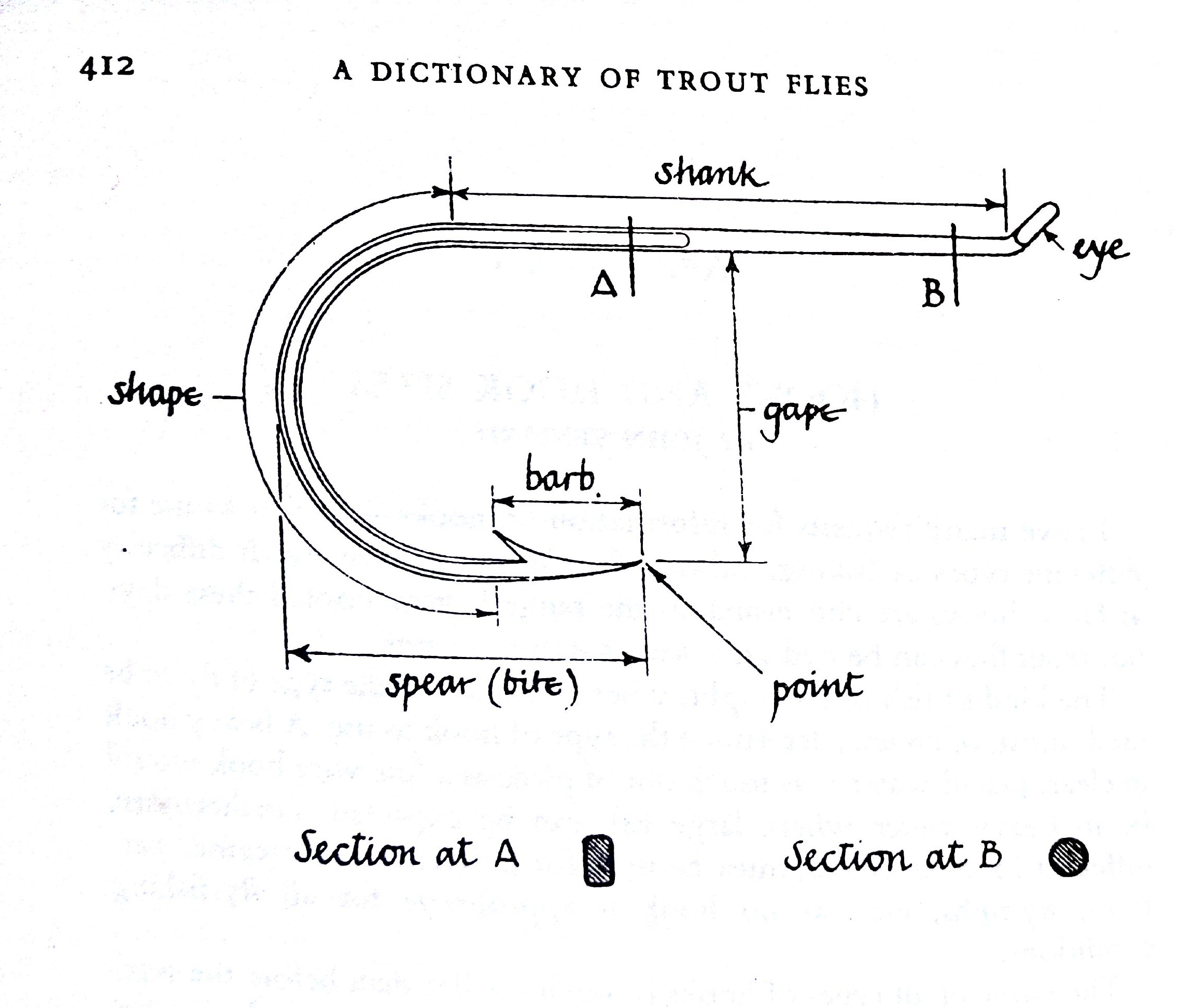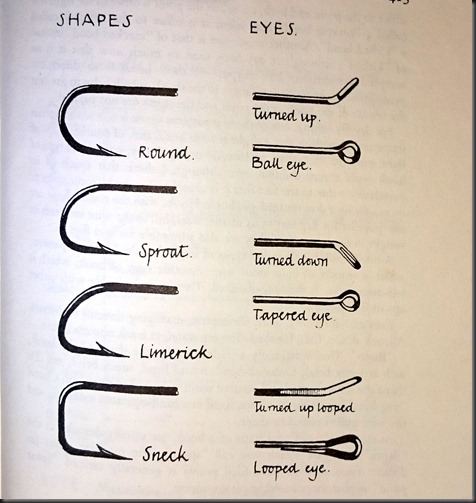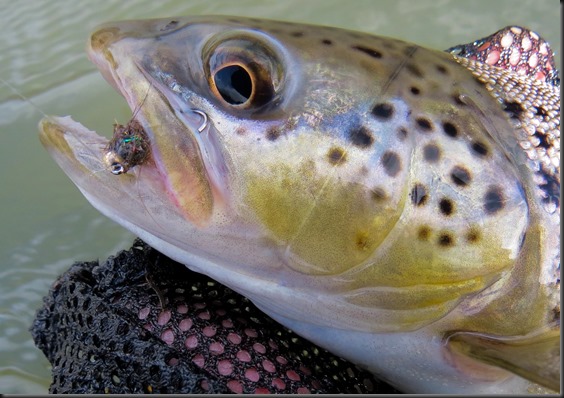In looking through my boxes of hooks a while back, I realised how many “bad” hooks I had in there. By “Bad”, I mean ones that, if you break it down, are not really any good to anyone. I am talking here of ultra longshank hooks, and small nymph hooks.
You see the ultra longshank ones are just long levers for helping the Trout rid itself of the sharp bit sticking it in the mouth. Well that is my theory, and I am sticking with it. Sticking with it more than an ultra longshank hook sticks in Trout skin!
And the nymph hooks: Give it a thought. Let’s just say I want to tie a nymph, with a body length of 10mm. I have a choice. I can use a #10 “wet fly”/standard shank hook, or I can use a #12 2XL long shank hook. Same shank length. Roughly. It depends which brand and model of hook we are talking about. But either way, it’s the same right?
Wrong!
Take a look at the gape width in each of the following hooks of similar shank length:

From left to right: TMC 5262; Grip 11001; Mustad R30; Grip 14012BL. Notice how the gapes are progressively wider from left to right. These hooks are all #12 incidentally!
The bigger gape (better hooking) comes from the bigger looking hook. The worst by far is the so called “nymph hook” at left. Sure, this big hook point dangling down below the dressing on the wider gape hook is more visible, but us flyfishers are blind to the glaringly obvious bend and hook point anyway, and the Trout seem to be too. Let’s face it: they don’t seem to see the bend, and the point, and the eye and the knot and the tippet. It’s pretty obvious stuff but they aren’t that sharp! If they were, we wouldn’t be catching any of them.
So that is why we are seeing more an more flies on standard shank hooks, even when the pattern is intended to be elongated in profile. I have had enough trouble with trying to hook trout on small emergers, so when it comes to the smaller sizes, I am a convert: large gape hooks it is, and those silly #16 long shank things are on mothballs.
While we are talking about things sticking in Trout skin, have a look at a modern barbless hook, vs an older style barbed hook. You may have noticed that the hook at far right in the picture above is a barbless jig hook.
Take stock of the length of that point.
If you were a six inch Trout, hooked in a small mountain stream, would you rather have that little barb (or maybe flattened barb) (hook at far left) in your lip, or the other serious steelwork (far right) up through your brain and out your eye socket?
OK, so I am dramatising to make a point, because in a high mountain stream with six inch Trout, you should be using a fly small enough that it doesn’t impale the fish like that. But consider for a moment, that perhaps this polarised thing of “I only fish barbless” and “You haven’t squashed the barb on that fly!” is a bit stale and only considering one aspect of the whole thing. The truth is I have impaled some unfortunate little buggers rather harshly over the years when they took a fly that was not anything other than small. (You know you’ve gone and done it when they go back with a droopy eye!) They were impaled on hooks with long points, and no one is talking about that. People just get all uptight when they see barbs. In the past, many barbed hooks had short points.
I have long been a proponent of fishing barbed hooks.
There. I said it.
…..awaiting more backlash than a certain cat shooting dentist……………
But before you admonish me for all the death and destruction I have caused:
I can’t remember when last I was unable to return a fish with just a quick twist, and I normally return them without lifting them from the water. Also, most barbs nowadays are what we used to call “whisker barbs”. Barb size has decreased considerably, and that is all for the better in my opinion. And if truth be told, I don’t advocate barbed hooks. I just use them and defend myself. I am also going to tell you, that when I one day plant a hook deep into my own being, I sure pray that it is a barbless one.
The other thing is, I have been losing a lot of fish on the strike, using some of my barbed hooks. (more about that below) So I am thinking of taking the gloves off now, becoming a real “meat hunter”, and going barbless…I mean LONG spear. Take a look at the LOOONG spear on barbless hooks. Here is a diagram to explain:

I borrowed this image from “A Dictionary of Trout Flies” by Courtney Williams. Look at what they mean by “spear” or “bite”
Some of these modern barbless hooks with their chemically sharpened point, meanly “rolled in” point (as they call that little upward facing twist), and long spear are downright evil! I like it. Really effective fish snaggers they are!
OK, so before I get ruthless and go “long spear”, why would I be a proponent of barbed hooks. Well you see it all goes back to the days before beads. Theo Bakelaar (Mr Goldbead) changed all this. We used to fish hooks with “Sproat bends” and “Limerick bends”. These were short spear hooks. The hook took a sharp bend just back of the barb, so they couldn’t penetrate very far. I mentioned these shapes to a buddy recently, and he hadn’t a clue what I was talking about. (He knows who he is! He’s the one who rolls his eyes at my barbed hooks!)
Let me educate the youngster, with the help of the dictionary:

See how the effective spear of the sproat and limerick could be limited, depending on how soon that bend started.
Digression: Effective spear is my own addition to the old hook diagram above. It is the spear as measured from the point of the hook, to the position where the angle of the hook bend prohibits any further penetration. A limerick bend hook tends to stop going in. How far does a round bend hook penetrate? I don’t know, but a good way around the bend. Measuring effective spear on a round bend hook is a bit of a hit and miss thing. Suffice it to say that in the tables provided here , I have been very conservative, and have measured only to where the shank starts to bend. A round bend hook can practically stitch a Trout! See the Bushmans River Trout below, practically “stitched” by a barbless round bend hook! (see: proof…I do fish barbless already!)

This got me thinking about all the nymph hooks nowadays, which, quite apart from being long speared and barbless, have to have a round bend to accommodate all the beads we use. Beads don’t go around a limerick bend you see.
So the evolving barbless trend, plus the round bends necessitated by beads, has produced these evil long speared hooks, on which the hook-ups are GREAT.
Does it really make that much difference?
I think it does. Take a look here:

These are hooks from far left and far right in the first picture. These are both round bends, so as to compare apples. Here are some key measurements on these #12 hooks:
| TMC 5262 | Grip 14012 BL | |
| shank length | 11mm | 9.2mm |
| gape | 3.9mm | 5.5mm |
| spear | 5mm | 7mm |
| effective spear | 4mm | 6.2mm |
There is quite a difference isn’t there. Look at it in percentages. effective spear is 55% longer on the barbless hook!
Now, about those fish that I have been losing on the strike:
Take a look at these hooks and their specs:

left to right: #12 Partridge 15BN and Grip 14582
| Partridge Klinkhamer 15BN | Grip 14582 | |
| gape | 6.5mm | 4mm |
| spear | 6.5mm | 5mm |
| effective spear | 5mm | 4.6mm |
That percentage again: the proper klinkhamer has 9% more effective spear length. Perhaps more relevant, the gape is 62% wider!
The relevance of this is that I have been a “cheapskate” and have been bending a Grip 14582…the one pictured on the right above…. to make a klink hook!
I have also been struggling to connect on these recently. Having photographed the above hooks and measured them with my caliper, I can now guess why!
No more “cheapskate!”. The proper Klinkhamer has a better spear than even the nymph hooks, and is not far behind that Grip Jig hook , and the gape is even better!
* Another digression: Hans Van Klinken’s special hooks are now made by Daiichi, and Partridge were spelling it with an extra M after they parted ways with Hans. …
Have a look at Tom Sutcliffe’s site for an article on the Klinkhamer by Hans himself.
Partridge now seem to be spelling it with one M again in the “Klinkhamer x-treme” hooks, and are saying something about “This hook is now exactly as designed by Hans van Klinken. It is now possible Partridge to make it according to the original plan. Designed as the ideal hook for tying the famous Klinkhamer designed by Hans van Klinken” Sounds fishy. I wrote to Hans, and he confirmed that the real deal is still the Daiichi, with whom he has a happy association…….. Get the real thing.
End of digression.
So what am I saying? I am not sure. I think I am saying that barbless hooks are not as pure as driven snow, and that some guys need to get off the high horse. I think I am saying that as a barbed hook guy, with a mean “meat hunter” streak in me, I am going to use barbless hooks more. And I think I am saying that I am questioning the hook-up benefits of various terrestrial hooks (limerick type bend) in comparison to these barbless hooks, but that proper Klinkhamer hooks are great.
Either way, if we meet in the pub we can do some back slapping and name calling, and while I am now unsure as to who will be calling the other a “meat hunter”, I am sure that I will want to buy you a beer and that the banter will all be in good spirits.
All puns in this essay are intentional.
10 Responses
Andrew .. Personally, I believe what you are proposing is not all that out-of-line at all. But it is dangerously controversial. Well, at least to those who enjoy dwelling in the co-mangled dynasty of the ditch-to-ditch mentality: all barbs vs all barbless. Instead, you are – in my book – rightly proposing a return to a ‘Balanced’ approach to the use of fish hooks. Imagine what possibilities !???! Good thought piece. I hope others will give your comments a good hard, ‘Think’.
Thank you Arthur. It is sure to stir a few comments and conversations, but that is always healthy, informative and entertaining.
Very interesting Andrew, I am going to disagree about the barbless hooks, as I am sure you expected I would. Fishing ultralight tackle , #2 and such barbs are doorstops that prevent the fly penetrating on the strike. So not good for the fisherman or the fish. Down here in the Cape we started fishing barbless before catch and release became the norm. We did it because we caught a LOT more fish with them. Agreed however that these ultra-long points on some hooks are potentially lethal for small fish.
But more anglers should spend a lot more time thinking about the hooks, Up Eyed dry fly hooks all went in my dustbin thirty years ago, they don’t offer a good angle of penetration for hook ups and missed fish are pretty much the norm.
Then as you say, those hooks with tiny gapes in comparison to their size, pointless if you will forgive the pun. Equally I don’t like these in turned points on hooks, particularly for dry fly work. On nymphs they seem to work fine but I suspect that is the difference in the angles when the fish takes the fly.
One thing that you didn’t mention, and something that is a near religion with me, people don’t sharpen their flies, chemically sharpened hooks have simply been acid washed to remove tiny burrs left by the mechanical sharpening process. They are not that sharp. A proper diamond dust hook sharpener and a few strokes and one would be amazed at the difference. Thanks for the mental stimulation, and one thing on which we both agree, thinking more about the hooks we use cannot be a bad thing..
Thanks for your valued points Tim, and in particular for that bit about hook points. I always go with the rule that if the hook point cant scratch your thumbnail, then it is blunt. I must admit though, that they seem to be doing something better when hey make hooks, because my hooks dont seem to need sharpening like they did in the old days. Maybe I have dropped my standards? Or maybe our flies come into contact with fewer rocks here in KZN (especially meadow type water) than in the Cape. I am off to give my hook points a thorough looking over!
Further discussion on this post: https://www.facebook.com/andrew.fowler.79677/posts/1027408310612343
Andrew/Tim,S
Something I experienced yesterday was 5 out of 6 fish hooked on a barbless hook came free ( long line release ). I am very puzzled by this as most came free under tension. i have been trying to analyze why this occurred. I have come to the conclusion that maybe the reasons were:
The fly I tied had an orange brass bead at the eye.
The fly was quite small #12 &
The dubbing on the body was perhaps a little to heavy.
Could the weight of the bead at the eye have caused a problem?
The most likely problem is that the fish were turning away at the last minute, and getting “foul hooked” on the hard outer mouth parts or gill covers, where the hook doesn’t penetrate well, and any pulling pulls the hook point away, unlike a nice secure hooking in the scissors. A bead would not help the cause, but I think a fly change, and (though it sounds counter intuitive), a smaller pattern MAY help more than ditching the bead. This is a real guessing game though! Any other thoughts on the problem?
I always have been a closet barbless hook guy. This was reinforced about 18 months ago when my 8 year old son caught a barbed hook in his right calf muscle….R 1,000 plus later for after hours casualty fees has resulted in me being a Hardened Barbless Zealot! Thanks Andrew for the entertaining words and picsw.
Interesting read. I recently tied up some Once and Away paterns on Klinkhammer hooks. Daiichi 1160. Size 16. Hooked 4 nice size fish in my last 2 outings and lost all of them. Despite keeping constant tension on them they came unbuttoned. Wondering if the hook holding ability isn’t that good on these hooks. Maybe I should try a scud hook instead.